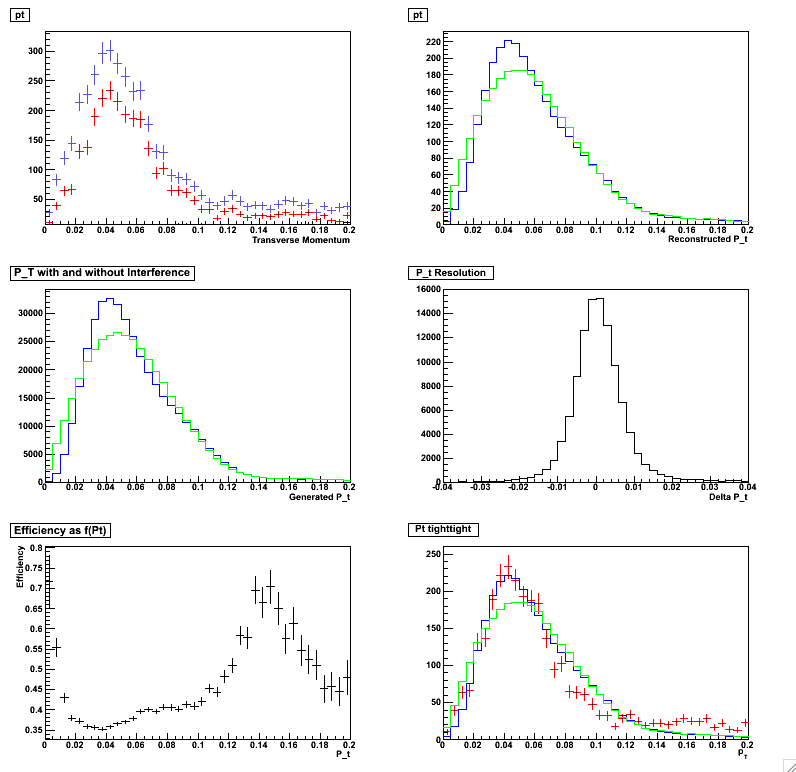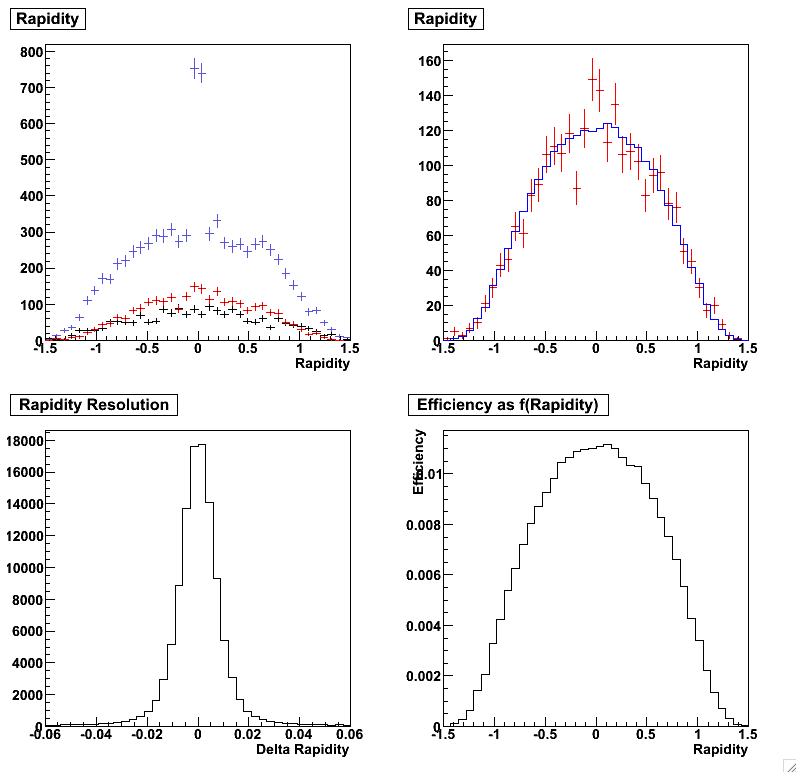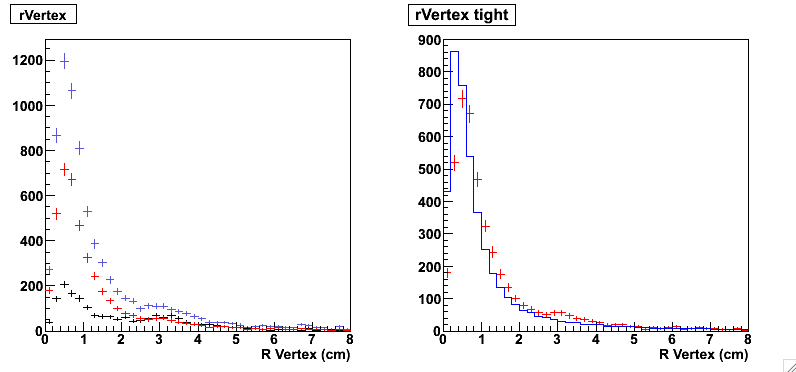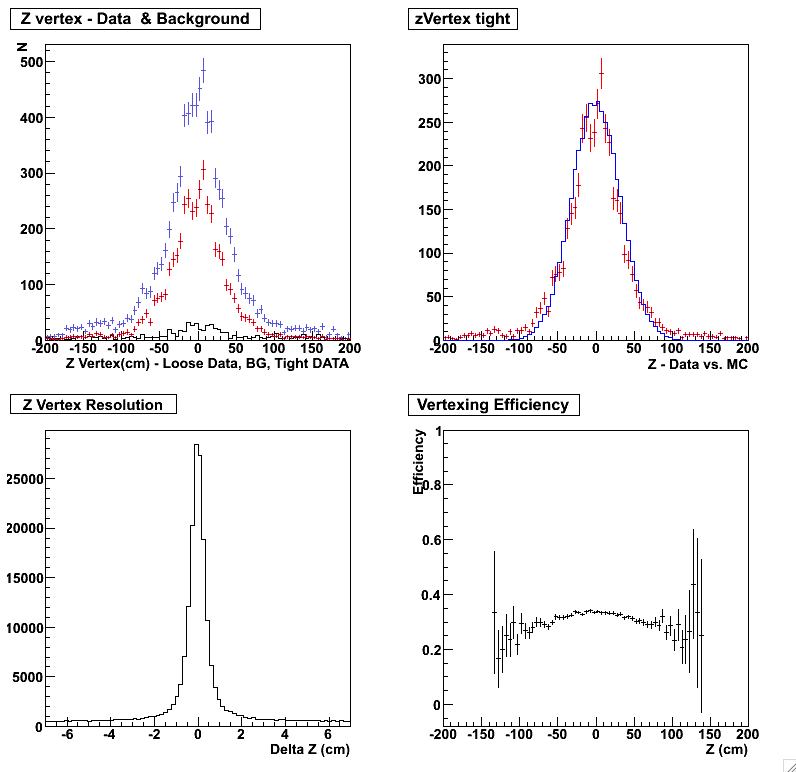Monte Carlo Comparisons
Minimum Bias Monte Carlo Comparisons
A large number of comparisons were made between the data and the Monte Carlo.
For the minimum bias data considered here, the agreement was excellent.
The comparisons were done cut-class by cut-class. There were 4 cut classes:
vertex (Z vertex and R vertex), &pi+&pi- mass and pT.
Comparisons were done by applying a basic set of cuts (Npr=Ntot=2, Qtot=0)
plus the other cut classes, and examining the cut variables under consideration.
Often, the raw distributions are shown after a very loose set of cuts
(only that there be a vertex); this can be useful for studying the effects of the cuts on the data.
The efficiency was also studied, and the resolution determined.
Note that pT is an important analysis variable; to study the other variables,
we used a cut pT < 200 MeV/c. Also shown are background studies; the background
is obtained by requiring Qtot &ne 0.
Monte Carlo mass comparisons.
The upper left histogram compares the data with loose cuts (blue),
tight cuts (red) and background (black). A peak is visible at M(&pi&pi)=M(Ks).
This may be due to photoproduction of the &phi, followed by &phi --> KsKl.
Because the Q value of the phi decay is so low, most of the KS still make the
pT cut; the KL usually vanishes without decaying.
The upper right plot compares the data and the Monte Carlo; except for the Ks,
the agreement is excellent. The lower left plot shows the efficiency; for
M&pi&pi > 550 MeV/c, the effiency is flat. The last plot shows
the M&pi&pi resolution of about 8.3 MeV.
 |
Monte Carlo pT comparisons.
Although the analysis will use t=pT*pT, pT histograms give a slightly different look at the data.
The upper left histogram compares the pT spectra with loose (blue) and tight (red) cuts.
Events with pT >120 MeV/c appear consistent with incoherent rho production,
&gamma p --> &rho p.
The upper right plot compares the 'Int' (blue) and 'Noint" (green) pT spectra, after simulation
and reconstruction. The middle left histogram compares the 'Int' (blue) and 'Noint' (green)
pT spectra directly from STARlight, with no detector effects.
The middle right histogram shows the pT resolution is centered at 0, with &sigma=7.5 MeV.
The lower left histogram shows that the reconstruction efficiency is independent of pT,
except for the lowest bin, which is somewhat higher. This is probably due to pT smearing.
With the 'Int' spectrum (used here, since it matches the data better), the first bin has many
fewer events than the next bin, so that there is smearing from bin 2 --> bin 1, but very little
in the other direction. The lower right plot compares the pT spectra of data (red),
'Int (blue)' and 'Noint' (green).
 |
Monte Carlo rapidity comparisons.
The upper left histogram compares the data with loose cuts (blue), tight cuts (red),
and background (with loose cuts). The loose cut plot shows an enhancement for |y|<0.1.
This is likely due to cosmic rays, which are reconstructed as pairs with y=0, pT=0.
The upper right histogram compares the data (red) and Monte Carlo (blue),
while the lower left histogram shows the rapidity resolution, 0.01. This is
very adequate for the analysis. The lower right histogram shows the efficiency
as a function of rapidity. It is not flat, since the probability of a daughter
pion being outside the TPC acceptance rises as rapidity rises, but since the data
and MC agree well, this is no cause for concern.
 |
Monte Carlo rVertex comparisons.
The left plot shows the data with loose cuts (blue), tight cuts (red), and the background (black).
With the loose cuts, a small rise is visible at R ~ 3cm.
This disappears once tighter cuts are imposed.
The background rate is so high here because there is no cut on z.
The plot on the right compares the data (red) and the Monte Carlo (blue). The agreement is good.
 |
Monte Carlo zVertex comparisons.
The upper left histogram compares the data with loose cuts (blue) and tight cuts (red),
and the background (black). The upper right histogram compares the (red) data and
Monte Carlo (blue). The lower right is the resolution estimated with the Monte Carlo (zVertex-zMC);
the resolution is 2 cm. The lower left shows the efficiency as a function of zVertex.
It is approximately flat within the +/- 50 cm cut range.
 |




